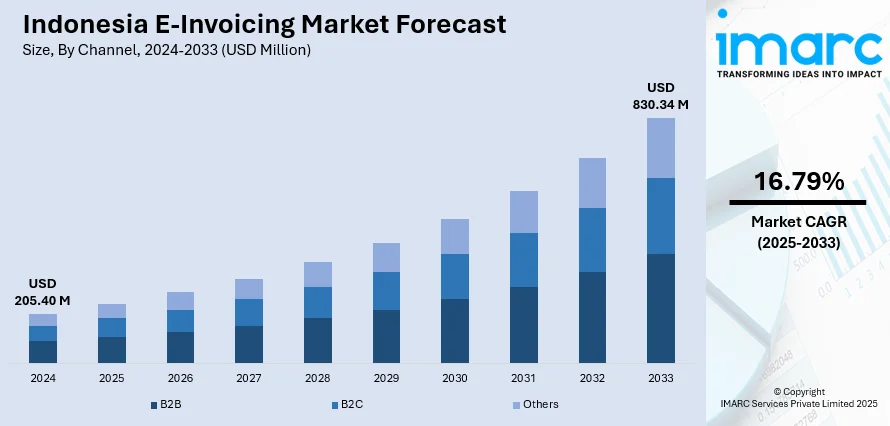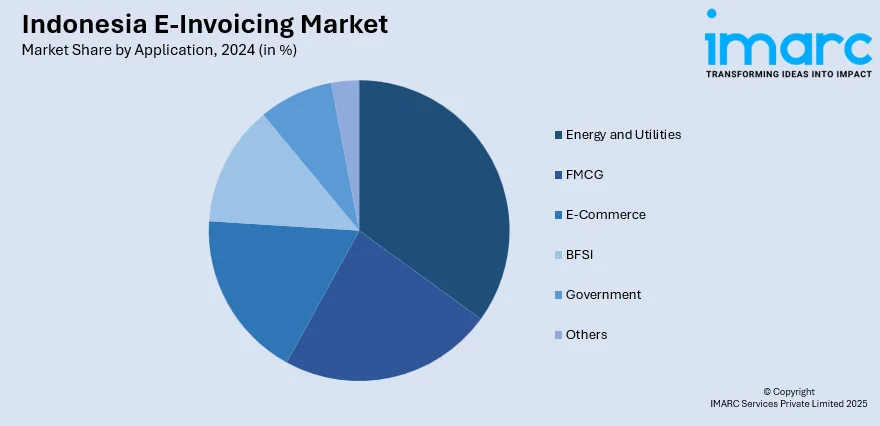
Indonesia E-Invoicing Market Size, Share, Trends and Forecast by Channel, Deployment Type, Application, and Region, 2025-2033
Indonesia E-Invoicing Market Overview:
The Indonesia e-invoicing market size reached USD 205.40 Million in 2024. Looking forward, IMARC Group expects the market to reach USD 830.34 Million by 2033, exhibiting a growth rate (CAGR) of 16.79% during 2025-2033. Government mandates for tax compliance, increasing digitization among SMEs, real-time reporting requirements, cost-saving benefits, rising ERP adoption, and efforts to curb VAT fraud are some of the factors contributing to Indonesia e-invoicing market share. Growing internet penetration and cloud-based solutions also support widespread implementation.
|
Report Attribute
|
Key Statistics
|
|---|---|
|
Base Year
|
2024 |
|
Forecast Years
|
2025-2033
|
|
Historical Years
|
2019-2024
|
| Market Size in 2024 | USD 205.40 Million |
| Market Forecast in 2033 | USD 830.34 Million |
| Market Growth Rate 2025-2033 | 16.79% |
Indonesia E-Invoicing Market Trends:
Push toward Automated Tax Administration
Indonesia is advancing its digital tax infrastructure through the rollout of the Core Tax System (Pembaruan Sistem Inti Administrasi Perpajakan or PSIAP). This initiative is focused on automating and simplifying tax-related services. By enabling taxpayers to independently access services and auto-complete tax forms, it reduces manual processes and minimizes errors. The approach also supports greater transparency in tax reporting, building trust between the government and taxpayers. As the system becomes operational, it is expected to drive stronger compliance, reduce administrative burdens, and improve overall efficiency in tax collection. This shift supports the broader move toward integrated digital invoicing and aligns with efforts to modernize fiscal systems across sectors. These factors are intensifying the Indonesia e-invoicing market growth. For example, in July 2024, the government introduced plans for the Core Tax System (Pembaruan Sistem Inti Administrasi Perpajakan or PSIAP), aimed at automating and digitizing tax administration. The system is designed to let taxpayers handle services on their own, auto-fill tax return forms, and improve transparency.

To get more information of this market, Request Sample
Strengthening Compliance through Digital Infrastructure
Government-backed initiatives in New South Wales are spotlighting the role of advanced technologies in heavy vehicle operations. Recent safety guidelines recommend the integration of automatic e-invoicings to enhance stability and reduce wheel slip, especially in challenging road conditions. This is encouraging logistics operators and fleet managers to prioritize vehicles equipped with such systems to comply with best practice frameworks. The focus on minimizing risk in freight transport is reinforcing the value of embedded control technologies across Indonesia’s commercial vehicle segment. As regulatory awareness grows and safety protocols become more specific, original equipment manufacturers and retrofitters are expected to increasingly align product offerings with these safety expectations, reinforcing the use of ATC in both new and existing fleets. For instance, in March 2024, Transport for NSW released a guide detailing safety technology for heavy vehicles, including automatic traction control (ATC) systems. The guide outlines the benefits of ATC in enhancing vehicle stability and reducing wheel slip, contributing to safer road transport operations in New South Wales.
Indonesia E-Invoicing Market Segmentation:
IMARC Group provides an analysis of the key trends in each segment of the market, along with forecasts at the country and regional levels for 2025-2033. Our report has categorized the market based on channel, deployment type, and application.
Channel Insights:
- B2B
- B2C
- Others
The report has provided a detailed breakup and analysis of the market based on the channel. This includes B2B, B2C, and others.
Deployment Type Insights:
- Cloud-based
- On-premises
A detailed breakup and analysis of the market based on the deployment type have also been provided in the report. This includes cloud-based and on-premises.
Application Insights:

- Energy and Utilities
- FMCG
- E-Commerce
- BFSI
- Government
- Others
A detailed breakup and analysis of the market based on the application have also been provided in the report. This includes energy and utilities, FMCG, e-commerce, BFSI, government, and others.
Regional Insights:
- Java
- Sumatra
- Kalimantan
- Sulawesi
- Others
The report has also provided a comprehensive analysis of all the major regional markets, which include Java, Sumatra, Kalimantan, Sulawesi, and others.
Competitive Landscape:
The market research report has also provided a comprehensive analysis of the competitive landscape. Competitive analysis such as market structure, key player positioning, top winning strategies, competitive dashboard, and company evaluation quadrant has been covered in the report. Also, detailed profiles of all major companies have been provided.
Indonesia E-Invoicing Market News:
- In December 2024, Indonesia’s electronic invoicing system, e-Faktur, represented a major change in the country’s approach to taxation and billing. Overseen by the Directorate General of Taxes (DJP), it’s designed to boost transparency, streamline processes, and strengthen tax compliance.
Indonesia E-Invoicing Market Report Coverage:
| Report Features | Details |
|---|---|
| Base Year of the Analysis | 2024 |
| Historical Period | 2019-2024 |
| Forecast Period | 2025-2033 |
| Units | Million USD |
| Scope of the Report |
Exploration of Historical Trends and Market Outlook, Industry Catalysts and Challenges, Segment-Wise Historical and Future Market Assessment:
|
| Channels Covered | B2B, B2C, Others |
| Deployment Types Covered | Cloud-based, On-premises |
| Applications Covered | Energy and Utilities, FMCG, E-Commerce, BFSI, Government, Others |
| Regions Covered | Java, Sumatra, Kalimantan, Sulawesi, Others |
| Customization Scope | 10% Free Customization |
| Post-Sale Analyst Support | 10-12 Weeks |
| Delivery Format | PDF and Excel through Email (We can also provide the editable version of the report in PPT/Word format on special request) |
Key Questions Answered in This Report:
- How has the Indonesia e-invoicing market performed so far and how will it perform in the coming years?
- What is the breakup of the Indonesia e-invoicing market on the basis of channel?
- What is the breakup of the Indonesia e-invoicing market on the basis of deployment type?
- What is the breakup of the Indonesia e-invoicing market on the basis of application?
- What is the breakup of the Indonesia e-invoicing market on the basis of region?
- What are the various stages in the value chain of the Indonesia e-invoicing market?
- What are the key driving factors and challenges in the Indonesia e-invoicing market?
- What is the structure of the Indonesia e-invoicing market and who are the key players?
- What is the degree of competition in the Indonesia e-invoicing market?
Key Benefits for Stakeholders:
- IMARC’s industry report offers a comprehensive quantitative analysis of various market segments, historical and current market trends, market forecasts, and dynamics of the Indonesia e-invoicing market from 2019-2033.
- The research report provides the latest information on the market drivers, challenges, and opportunities in the Indonesia e-invoicing market.
- Porter's five forces analysis assist stakeholders in assessing the impact of new entrants, competitive rivalry, supplier power, buyer power, and the threat of substitution. It helps stakeholders to analyze the level of competition within the Indonesia e-invoicing industry and its attractiveness.
- Competitive landscape allows stakeholders to understand their competitive environment and provides an insight into the current positions of key players in the market.
Need more help?
- Speak to our experienced analysts for insights on the current market scenarios.
- Include additional segments and countries to customize the report as per your requirement.
- Gain an unparalleled competitive advantage in your domain by understanding how to utilize the report and positively impacting your operations and revenue.
- For further assistance, please connect with our analysts.
 Request Customization
Request Customization
 Speak to an Analyst
Speak to an Analyst
 Request Brochure
Request Brochure
 Inquire Before Buying
Inquire Before Buying




.webp)




.webp)












